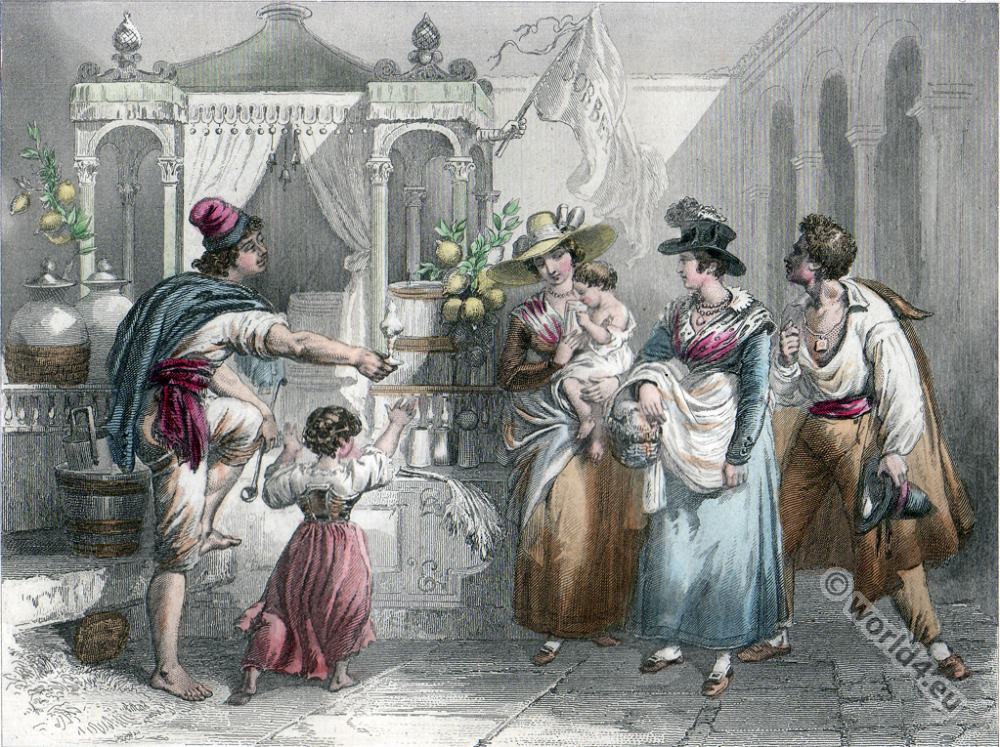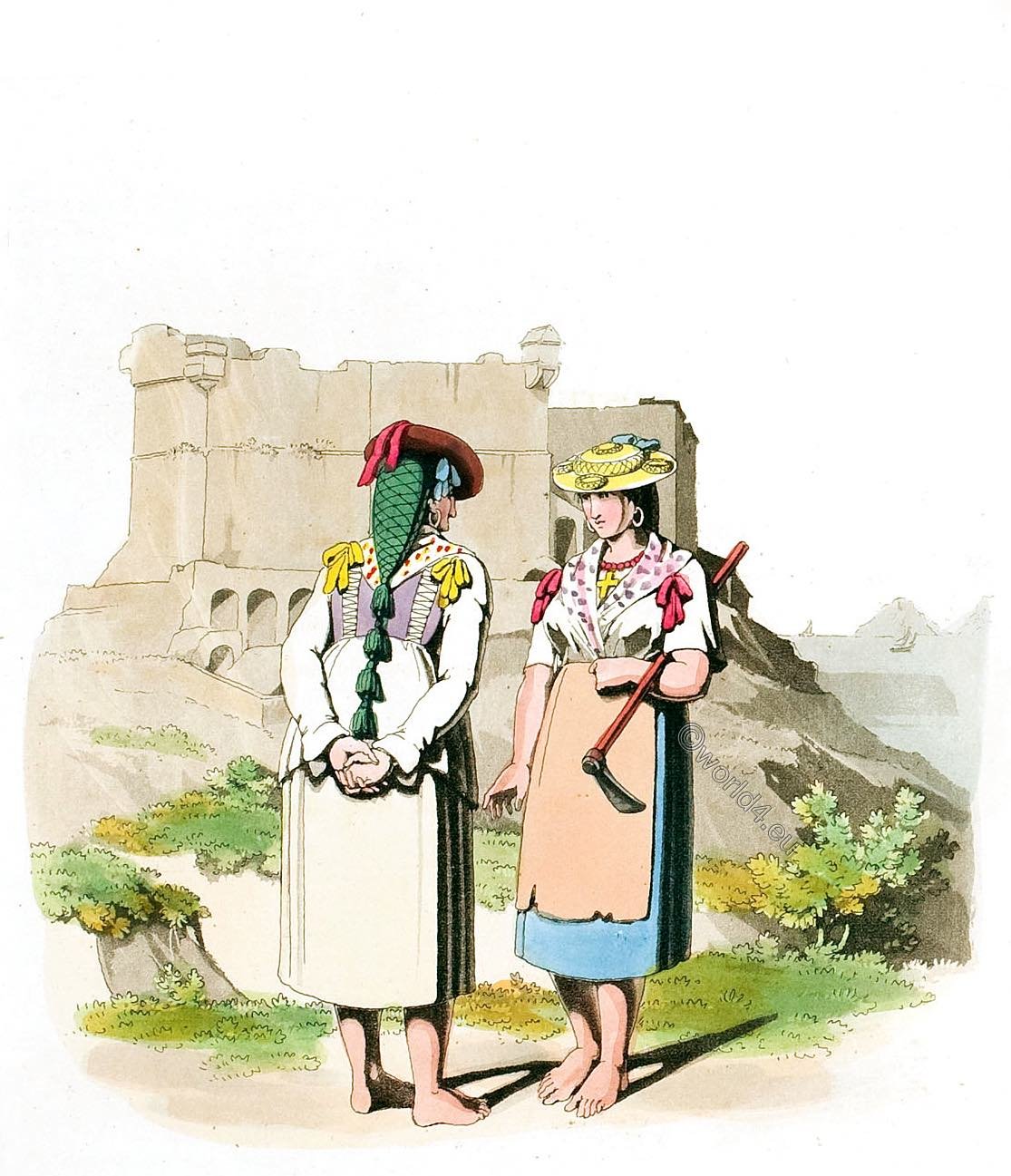
COSTUME AT LERICI.
THIS costume resembles in many points those commonly shown of the Swiss girls. The only remarkable difference is, the bag containing the hair, which, with its long tail, hangs down the back.
The ruin in the back ground is part of the Castle of Lerici, a prominent object from the gulf of Spezia.

Lerici is located at the eastern end of the Riviera, the French-Italian coastal stretch of the Ligurian Sea. Lerici is on the east side of the Gulf of La Spezia, also called Golfo dei Poeti. Opposite Lerici is Porto Venere. Lord Byron once swam the Gulf of La Spezia from Porto Venere to Lerici.
Dante already made this geographical attribution, comparing the steepness of the lowest rocky slope of Mount Purgatory in his work “Divine Comedy” to the cliff edge of the Riviera, which stretches from La Turbie (Italian: Turbia) to Lerici.
The large villas of the noble families were built in the 17th and 18th centuries. Lerici and its northern suburb San Terenzo developed into a holiday resort from the 19th century.
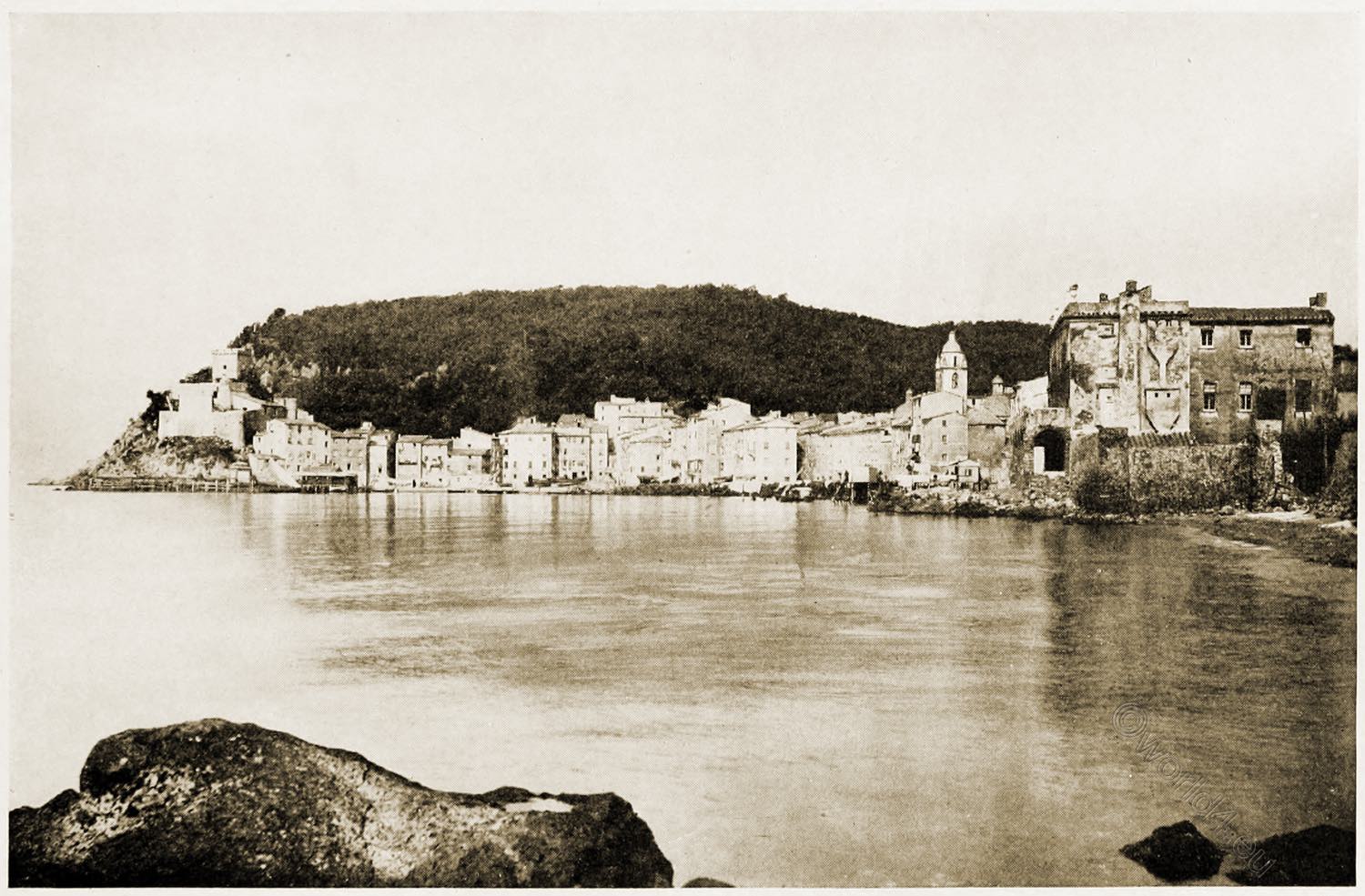
San Terenzo and the Bay of Lerici. Shelley’s house in foreground at the right. Photograph made about 1880, previous to building of modern road.
Percy Bysshe Shelley and his wife Mary Shelley rented the white beach villa “Villa Magni” in San Terenzo from April to September 1822. On 8 July 1822, the sailor Percy Bysshe Shelley was caught in a storm on his way back from Livorno and drowned. His friend Lord Byron had the body burnt on the beach at Viareggio, where the body had washed up. The popularity of Shelley and Byron led to the name Gulf of the Poets (Golfo dei Poeti) for the Gulf of La Spezia and attracted tourists and writers.
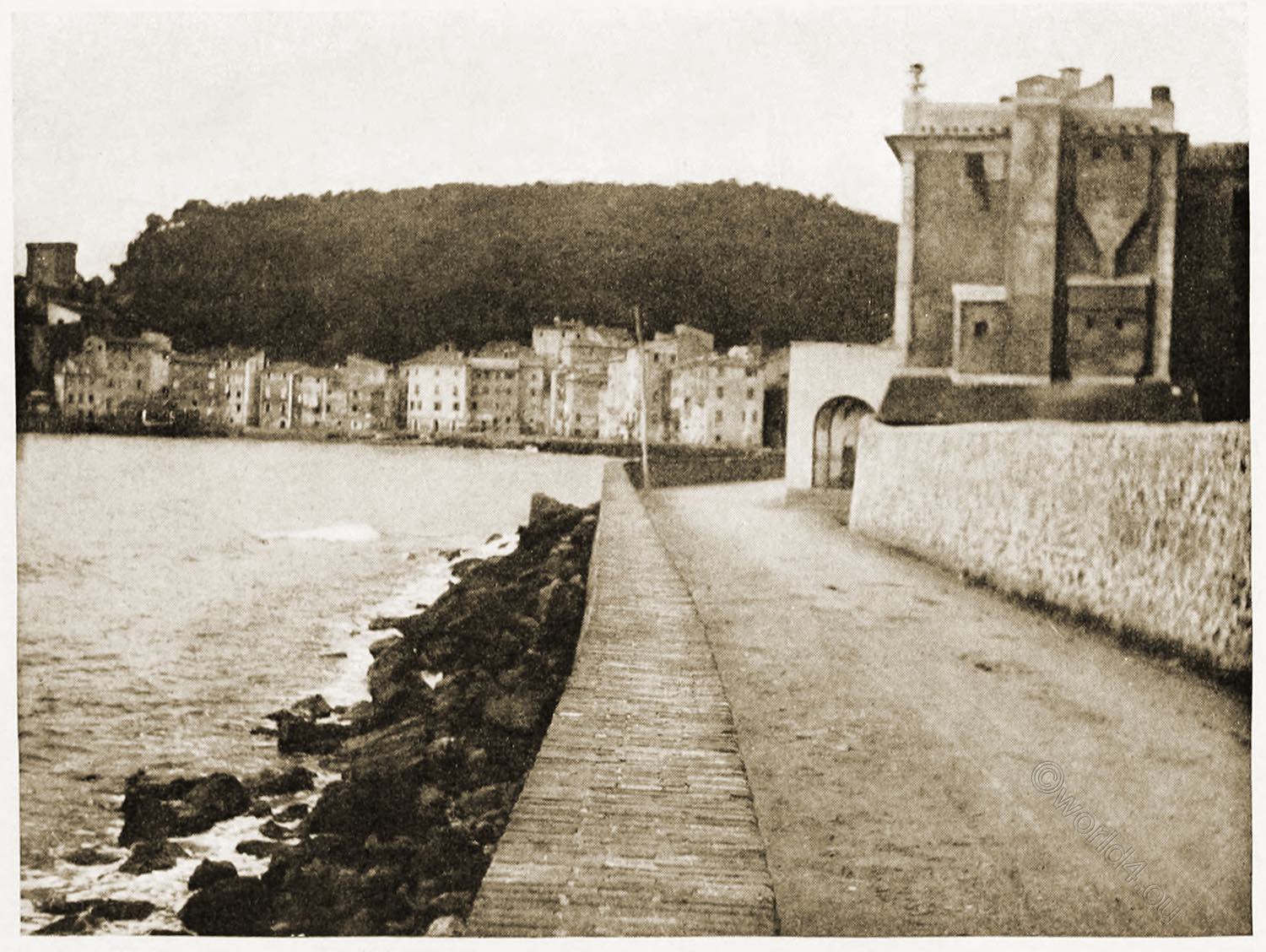
Shelley’s home on the Bay of Lerici. Photograph of 1904. See Letter to Leigh Hunt. *)
The Bay of Lerici, which gives its name to one poem and was the inspiration of several others, was Shelley’s last home.
“The blue extent of the waters, the almost land-locked bay, the near castle of Lerici shutting it in to the east and distant Porto Venere to the west; the varied forms of the precipitous rocks that bound in the beach; … the tideless sea leaving no sands nor shingle, … a picture such as one sees in Salvator Rosa’s landscapes only” are portions of Mary Shelley’s descriptions of the place, as true to-day as when they were written.
Here were passed Shelley’s happiest days; here, almost for the first time, he had something like health and serenity of spirits. The poem now begun — “The Triumph of Life” — is the expression of the attitude of mind which he had now attained — of peace achieved through passion, of insight gained through suffering and through error. Its opening lines, with its magnificent picture of sunrise and himself in waking vision
Beneath the hoary stem
Which an old chestnut flung athwart the steep
Of a green Apennine,
embalm the very spirit of the Italy which was so dear to Shelley’s heart and so mighty a power in his life, fragment as it is, it is yet a poem full of ethical and spiritual import. It breaks off suddenly with the line,
“‘Then, what is Life?’ I cried.”
But this question was to have no answer from Shelley. A sudden storm at sea capsized the boat in which he and his friend were sailing, and both were drowned almost within sight of their own home. Many days later both bodies were washed ashore near Viareggio. They were buried in sand on the beach. The harrowing details of the identification of the two bodies, their removal from the temporary graves and their burning on the shore a month later, the suspense suffered by the two widowed women in the lonely Casa Magni during the days when they hoped against hope and drove frantically from place to place along the shore hoping for tidings of the missing boat — are the distressing but well-known chapters that close the record of the Shelley household in Italy.

“You can have no idea what an extraordinary effect such a funeral pile has on a desolate shore, with mountains in the backqround and the sea before, and the sinqular appearance the salt and frankincense gave to the flame. All of Shelley was consumed except his heart, which would not take the flame.” – Lord Byron in letter of August 27, 1822.
Viareggio keeps his memory green by a monument erected in 1894 in its principal square, the work of an Italian sculptor. Here, each year, celebrations are held and laurel wreaths are placed, with speeches and poems by Italy’s most illustrious speakers and writers.
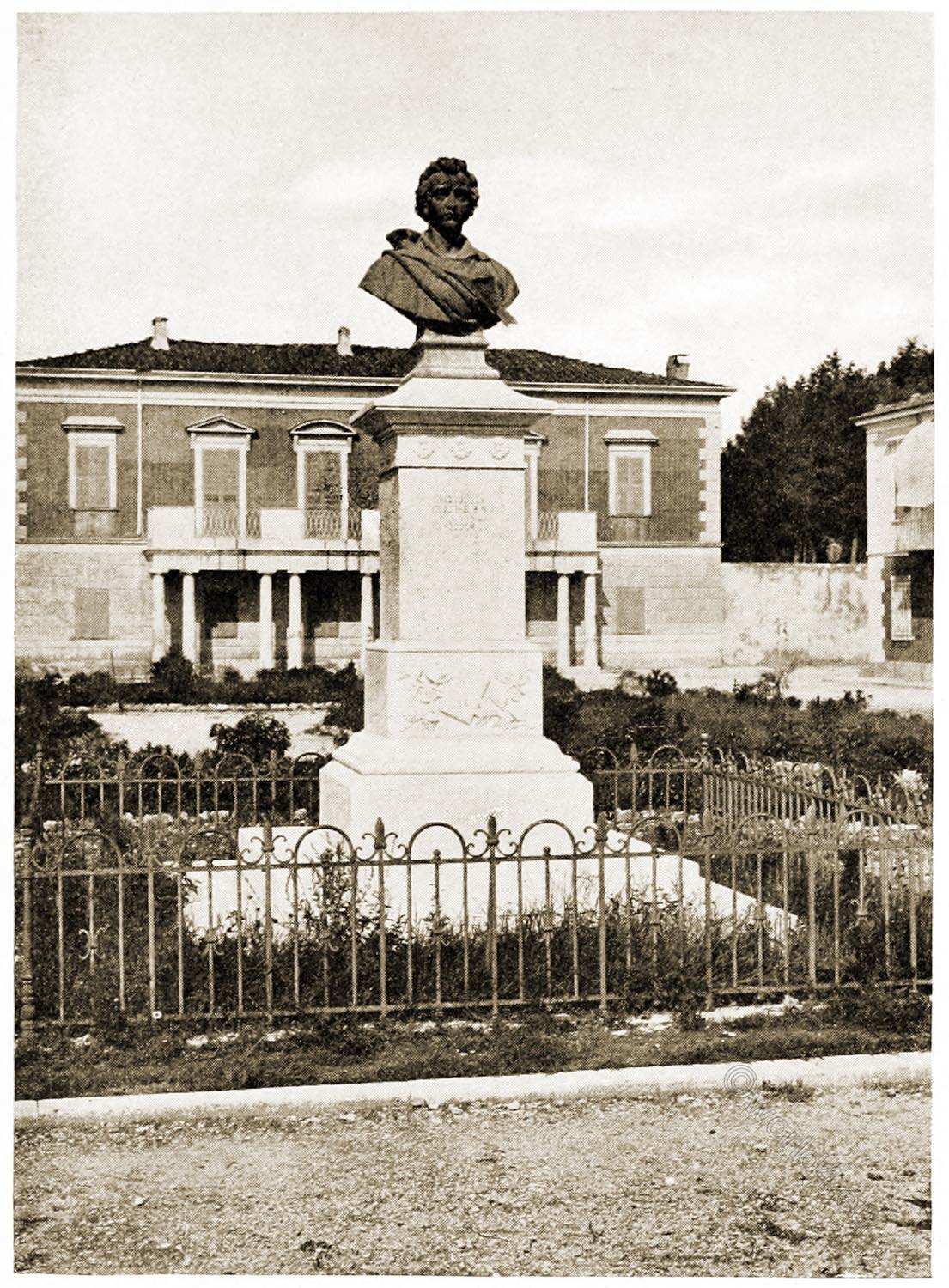
LINES WRITTEN IN THE BAY OF LERICI. 1822.
She left me at the silent time
When the moon had ceased to climb
The azure path of Heaven's steep,
And like an albatross asleep.
Balanced on her wings of light.
Hovered in the purple night,
Ere she sought her ocean nest
In the chambers of the West.
She left me, and I stayed alone
Thinking over every tone
Which, though silent to the ear.
The enchanted heart could hear.
Like notes which die when born, but still
Haunt the echoes of the hill;
And feeling ever — oh, too much! —
The soft vibration of her touch.
As if her gentle band, even now.
Lightly trembled on my brow;
And thus, although she absent were.
Memory gave me all of her
That even Fancy dares to claim: —
Her presence had made weak and tame
All passions, and I lived alone
In the time which is our own;
The past and future were forgot.
As they had been, and would be, not.
But soon, the guardian angel gone.
The daemon reassumed his throne
In my faint heart. I dare not speak
My thoughts, but thus disturbed and weak
I sat and saw the vessels glide
Over the ocean bright and wide.
Like spirit-winged chariots sent
O'er some serenest element
For ministrations strange and far;
As if to some Elysian star
Sailed for drink to medicine
Such sweet and bitter pain as mine.
And the wind that winged their flight
From the land came fresh and light;
And the scent of winged flowers,
And the coolness of the hours
Of dew, and sweet warmth left by day.
Were scattered o'er the twinkling bay,
And the fisher, with his lamp
And spear, about the low rocks damp
Crept, and struck the fish which came
To worship the delusive flame.
Too happy they, whose pleasure sought,
Extinguishes all sense and thought
Of the regret that pleasure leaves,
Destroying life alone, not peace!
The following writers have visited Lerici or San Terenzo: Henry James in 1909, Paolo Mantegazza in 1910, D. H. Lawrence, Virginia Woolf in 1933, Gabriele D’Annunzio and Sem Benelli.
*) Letter to Leigh Hunt.
TO LEIGH HUNT
(At Genoa)
Lerici, June 19, 1822.
My dearest Friend, — I write to you on the chance that you may not have left Genoa before my letter can reach you. Your letter was sent to Pisa, and thence for- warded here, or I should probably have ventured to meet you at Genoa ; but the chances are now so much dimin- ished of finding you that I will not run the risk of the delay of seeing you that would be caused by our missing each other on the way. I shall therefore set off for Leg- horn the moment that I hear you have sailed.
We now inhabit a white house, with arches, near the town of Lerici, in the Gulf of Spezia. The Williamses are with us. Williams is one of the best fellows in the world; and Jane, his wife, a most delightful person, whom we all agree is the exact antitype of the lady I described in ” The Sensitive Plant,’^ though this must have been a pure antici- pated cognition J as it was written a year before I knew her. I wish you need not pass Lerici, which I fear you will do; cast your eye on the white house and think of us.
A thousand welcomes, my best friend, to this divine country; high mountains and seas no longer divide those whose affections are united. … Give me the earliest intelligence of your motions.
Source:
- “Sketches Illustrative of the Manners and Costumes of France, Switzerland and Italy, by Richard Bridgens. London. Baldwin, Cradock & Joy. 1821.Text by J.W. Polidori. London. Baldwin, Cradock & Joy. 1821.
- With Shelley in Italy: a selection of the poems and letters of Percy Bysshe Shelley relating to his life in Italy by Percy Bysshe Shelley (1792-1822); Anna Benneson McMahan (1846-1919). London: T. Fisher Unwin, 1907.
Discover more from World4 Costume Culture History
Subscribe to get the latest posts sent to your email.






